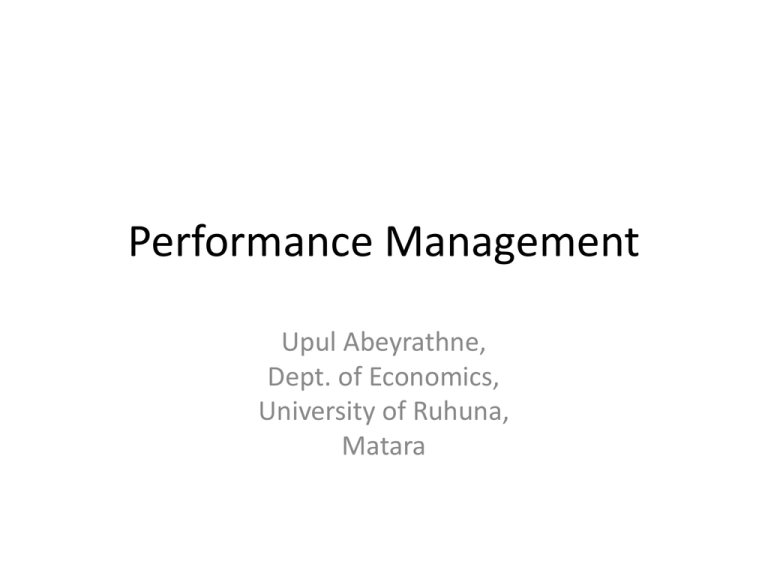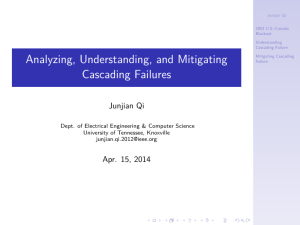Performance Management
advertisement

Performance Management Upul Abeyrathne, Dept. of Economics, University of Ruhuna, Matara Working Definition • It is means whereby accountability for contributing to the organization’s strategic or operational objectives is allocated to employees and where these contribution are measured objectively. • Outcomes are used to inform decision about further objectives and needs of the organization and its employees. Nature of Performance Management • It is a multi-level activity. • It is multi-arena Activity. • It links policy and managerial objectives to the needs and expectation of customers, job of people across units, agencies that are responsible for meeting these needs. • It involves monitoring and evaluating performance, feeding back into the system and learning how to bridge performance gaps. Traditional Definition • “Individual and Organizational performance is integrated with a set of planning and review procedures which cascade down through the organization to provide a link between each individual and the overall strategy of the organization” (Rashid 1999,18) • It integrates individual and organizational performance with planning and review procedures • Its objective is to link individuals and overall strategy of the organization. Changing Environment and Traditional Definition • This perception of performance as cascading down organizational strategy and priorities to individual is not adequate. • The new environment demands cascading upward not downward. • New organizational management demands to reach customers, listening to them of their needs and priorities, expectations, hopes and fears and the need of cascading them upwards before cascading begin downwards begins. performance Review 1. It involves setting policy objectives and measurable targets for their achievement. 2. It requires the creation of uncomplicated key performance indicators 3. Regular systematic review of results by reference to those indicators. 4. Identification of indicators and measurement provide the basis for review of performance of services compared with the targets and standards originally set. Deficiency of traditional perception • It narrowly focused on organization itself. • It does not acknowledge the shift towards multi-agency working across sectors which involves the levering in and influencing of resources to make things happen. • It does not recognize the need to involve others, key stakeholders, other providers agencies and communities Deficiency of traditional perception • The traditional approach links strategy and objectives of organization to jobs and people. • It is systematic and vary in degree of the formal structure. • The most detailed form is based on setting corporate, service, team and individual objectives • Recognizing achievement • Identifying training and development needs • Using the knowledge gained to modify objectives and methods as necessary. Deficiency of traditional perception • However, this systematic approach alone is not sufficient. • Organization’s ways of working, culture, system and processes, control tools, involvement of stakeholders need to contribute to a more coherent and holistic approach to future performance management system. Deficiency of traditional perception • Traditional approach is about motivating staff by concentrating on priority objectives, raising commitment and releasing potential. Key terms • Aims: the general outcomes that are to be achieved through actions or activities • Objectives: The specific overall impact that is to be achieved by undertaking specific actions or activities • Targets: A special task that need to be achieved and above routine work • Inputs: The Cost and Resources • Outputs: Goods and Services • Outcomes: The impact of the services delivered • Efficiency : the relationship between inputs and outputs Key terms • Evaluation : Checking whether the organization is achieving its objectives • Benchmarking: The process of measuring an organization performance against the performance of another organization which may be recognized as “best I class” • Performance Appraisal: The activity of evaluating actual achievement against the set targets • Performance Indicators: Yardsticks used to assess the achievement. Key Challenges for Performance Management • How to get involve stakeholders • Linking individual and team priorities to Customers needs • Commitment to Customer and honest feedback • Addressing performance Gap. It occur when more than one party is responsible for doing the activity. • Too often poor performance has directed attention away from it due to more urgent matters and priorities of the organization Key Challenges • Switching and levering in Resources: When a gap occurred there are a number of routes to address it. • Influencing and negotiating new targets • Contribution of financial and other resources from other areas of the organizational activity or persuading others to contribute • Building strategic alliance is means of overcoming many difficulties • Performance information: Timely ,accurate information contribute more informed decision making at all level of the organization Why performance Management • It provides clarity about who is responsible and accountable for ensuring objectives are achieved and with whom, by when and what the expected outcomes are • Focuses on organizational priorities, harnessing organization's energy to those ends • Provide a balanced approach to monitering and evaluating performance, learning and Feed backing issues to bridge the performance gap. Why Performance Management • Clarifies what is expected of individuals, teams and other organizations who are contributing to shared goals • Allows feedbacks to individuals and teams and stakeholders. • Creates more openness and honesty about what can and cannot be achieved • Demonstrates to interested parties that best value is being achieved Why Performance Management • Supports levering in of resources to maximize the organization’s overall performance • Enable effective use of limited resources • Encourage learning from the causes of mistakes and sucessses • Improves communication inside and outside the organization • Celebrates achievement, raising staff moral and selfesteem. • Tailor development and training for those who are charged with making thongs happen Ways of increasing Performance • Staff Development • Performance Related Pay Staff Development • It takes a variety of forms • Shall have to be treated as organic rather than mechanistic process. • Staff development and staff appraisal are interrelated. Step in staff Development • Accountability : Identify the purpose for which the job exists. It is accepted that the accountability should be not more than seven or eight in numbers. They will describe measurable results and enable assessment of how responsibilities are met. • Objectives (Goals): Objectives will indicate the priorities of a job. They will indicate specific measurable achievements expected over time and they will be based on standards and accountabilites. Steps in Staff Development • Performance measures and Indicators : These are used to assess achievement of accountabilities and objectives. They will be quantitative and qualitative. • Performance Standards: These are targets level of performance, based on performance measures that are used to set goals and assess achievements • Action Plan: These will indicate the method for achieving accountabilities and objectives. They will be used to plan work and monitor progress. They cover assumptions, constrains and deadlines. • Staff Development interview: Help to identify performance gap and training needs Staff Development and link with other management systems • • • • • • • • • • Strategic corporate service and departmental plans Resource allocation and budgetary control Recruitment and retention policies Job evaluation Salary and grading Training and development policy Quality issues Promotion and succession planning Disciplinary and grievances procedures Review of personnel Records Performance Related Pay • It is only one elements of rewarding performance.










